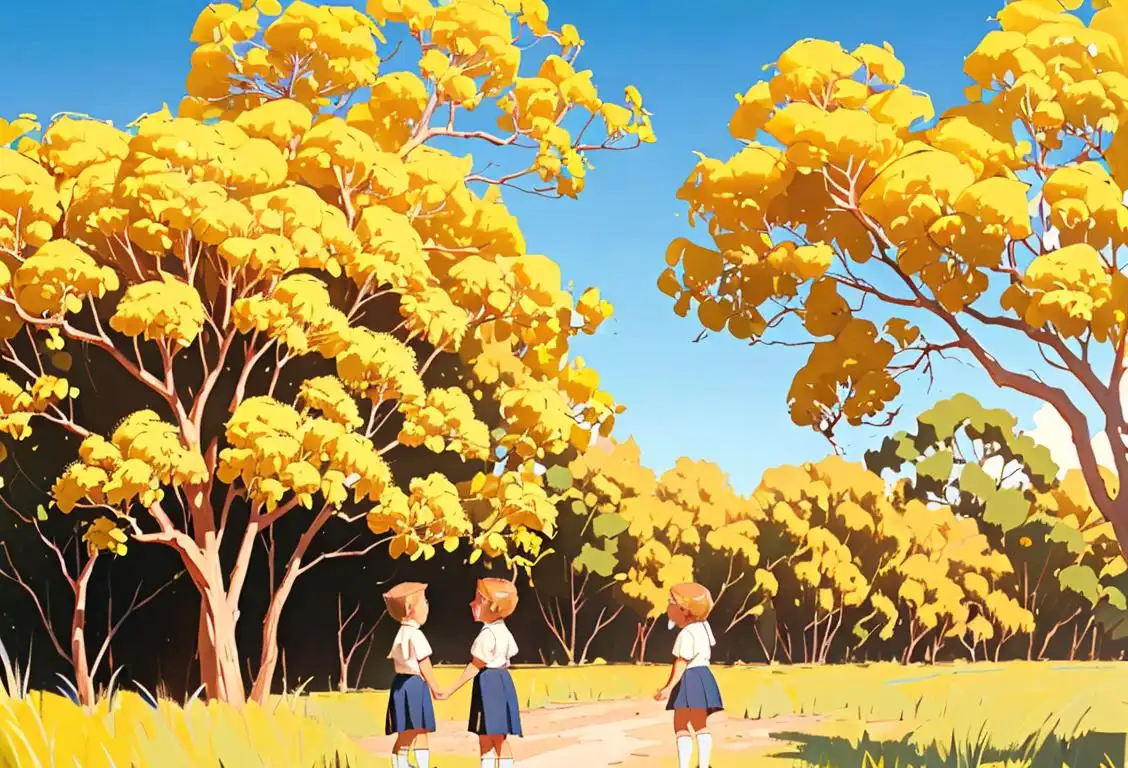National Wattle Day

Welcome to National Wattle Day, a day dedicated to the vibrant and golden symbol of Australia, the wattle! Get ready to dive into the fascinating world of this exquisite plant and discover why it's worth celebrating.
When is Wattle Day?
It's national wattle day on the 1st September.
The Birth of National Wattle Day
Every year on September 1st, Australians come together to commemorate National Wattle Day and pay tribute to the beautiful wattle plant. But how did this delightful celebration come to be?
The first official National Wattle Day was celebrated in 1910, making it one of Australia's oldest national days. The day was introduced by the Wattle Blossom League, a women's organization that aimed to promote the beauty and significance of wattle in Australian culture.
Wattle has deep roots in Australian history and identity. Its bright yellow flowers symbolize resilience, endurance, and unity—the same qualities found in the Australian people.
Fun-Filled Wattle Day Activities
Celebrating National Wattle Day is all about embracing the Aussie spirit and immersing yourself in wattle-themed festivities. Here are a few ideas to get you started:
- Organize a wattle-themed picnic with your loved ones. Pack some delicious Australian treats, set up your picnic blanket, and bask in the golden glow of wattle flowers.
- Go on a wattle walk and explore nature's goldmine. Discover the various wattle species in your area and marvel at their unique beauty.
- If you're feeling creative, why not make your own wattle-inspired crafts? From wattle wreaths to paper flower decorations, the possibilities are endless.
Did You Know?
Did you know that there are over 1,000 different species of wattle? Talk about a blooming family tree! These diverse plant varieties range from small shrubs to tall trees, each boasting its own unique charm.
History behind the term 'Wattle'
1600
The First Mention
In the year 1600, the term 'wattle' was first recorded in English literature. It referred to a framework of woven sticks or branches used in the construction of walls and fences. This traditional building technique dates back centuries and was commonly employed by various ancient civilizations, such as the Ancient Egyptians and Romans.
1000 BCE
Ancient Origins
Wattle has its origins in ancient times, dating back to around 1000 BCE. The term 'wattle' originally referred to the intertwining of pliable branches to create a woven framework for construction. Ancient civilizations, such as the Egyptians, Greeks, and Romans, used wattle extensively in the construction of various structures, including walls, fences, and roofs. This method provided flexibility, strength, and insulation.
12th Century
Wattle and Daub
During the 12th century, the term 'wattle' gained additional significance with the introduction of the construction technique known as 'wattle and daub.' This technique involved weaving thin branches (wattle) between upright stakes to create a framework. The gaps between the branches were filled with a mixture of clay, sand, and straw (daub), creating a sturdy and insulating surface for walls. Wattle and daub became a popular method of construction in medieval Europe and beyond.
1770
Captain Cook's Discovery
In 1770, during Captain James Cook's voyage to Australia, he observed the indigenous Aboriginal people constructing fences and shelters using woven branches or sticks. Impressed by the ingenuity of this technique, he adopted the term 'wattle' to describe these structures. This marked the introduction of the term to the wider English-speaking world.
18th Century
Fencing and Enclosures
In the 18th century, the term 'wattle' expanded its usage beyond construction. It became associated with fencing and the creation of enclosures. Wattle fences were commonly made by weaving supple branches or twigs together, often with the help of stakes, to create a barrier. This technique allowed for the construction of temporary or permanent enclosures to contain livestock or demarcate boundaries.
19th Century
Wattle as a Symbol
During the 19th century, the term 'wattle' started to gain symbolism in Australian culture. As the construction method using woven branches was prevalent across the country, 'wattle' became associated with the Australian way of life and their connection to the land. It represented resilience, resourcefulness, and the ability to adapt to harsh conditions.
20th Century
Symbol of Australian Identity
As the term 'wattle' continued to evolve, it found an enduring place in Australian culture during the 20th century. The golden flowers of the Acacia, commonly known as wattles, became an iconic symbol of Australia, embodying the country's vibrant identity. In 1988, the golden wattle (Acacia pycnantha) was officially declared as Australia's national floral emblem. Its blooming season coincides with Australia Day, celebrated on January 26th, making 'wattle' an integral part of the national celebration.
1988
National Wattle Day
In 1988, September 1st was officially recognized as National Wattle Day in Australia. This day celebrates the significance of wattle as a national symbol and its role in Australian identity. It highlights the beauty and diversity of the different wattle species found throughout the country. National Wattle Day encourages the planting, growing, and appreciation of wattle trees.
Present
Wattle's Global Recognition
Today, the term 'wattle' is recognized worldwide, particularly in reference to Australian flora and cultural heritage. Wattle has become an integral part of Australian art, literature, and ceremonial events. The vibrant golden flowers of the wattle tree are also a common motif in Australian floral emblems. The term continues to symbolize Australia's unique natural landscape and national pride.
Did you know?
Did you know that there are over 1,000 different species of wattle? Talk about a blooming family tree! These diverse plant varieties range from small shrubs to tall trees, each boasting its own unique charm.Tagged
awareness fun loved onesFirst identified
31st August 2015Most mentioned on
1st September 2020Total mentions
647Other days
Compliment Day
Cheese Pizza Day
Pumpkin Day
Medal Of Honor Day
Guac Day
Foundation Day
Suicide Prevention Day
Memorial Day
Cancer Survivors Day
Bacon Day









